|
Today in New Orleans History |
|
|
May 6 On May 6, 1883, the Daily Picayune reported that "a New Orleans concern
which H. C. Ramos is president and other leading buisness are interested" bought two stores at 2001 and 2005 Tchoupitoulas
Street (at St. Andrew Street) with plans to erect a plant for the manufacture of their product, Red Rock Ginger Ale.
Henry C. Ramos would gain greater fame in 1888 when he concocted the first Ramos Gin Fizz -- a mixture of gin, lemon juice, lime juice, egg white, sugar,
cream, orange flower water, and soda water -- at his Imperial Cabinet Saloon on Gravier Street.. Before Prohibition, Ramos had
over 20 bartenders working at the Imperial at once making nothing but the Ramos Gin Fizz - and still struggling to keep up
with demand. During the carnival of 1915, 32 staff were on at once, just to shake the drink.


 Mayor deLesseps Story "Chep" Morrison, Sr. (in office from April 4, 1946 –
July 17, 1961) was all about change and the "modernization" of New Orleans. Born in New Roads in Pointe Coupee
Parish on January 18, 1912, his family was related to Sidney Story, an alderman for whom the area of Storyville was named.
After moving to New Orleans, he became an attorney with the National Recovery Administration, a New Deal agency. Thereafter,
he became a law partner with his brother Jacob Morrison and Thomas Hale Boggs, Sr. As mayor,
Morrison sold most of the city's public markets, addressed a housing crisis by building veterans' housing operated by the
Housing Authority of New Orleans, and engaged in more large-scale urban renewal than any other New Orleans mayor. Morrison's
administration demolished low-income neighborhoods to build new or expand existing public housing projects and expropriated
private property to construct the New Orleans Civic Center (which included the then new City Hall), the New Orleans Union
Passenger Terminal, and several street-widening projects in the city's downtown district. The Civic
Center/City Hall was the brainchild of Brooke Duncan, the city Planning and Zoning Director in Morrison's administration.
As a young man during the 1920s, Duncan sold residential real estate and was a noted local golfer. In 1925 he became an associate
of Latter and Blum Realtors. During the 1930s, Duncan was appointed director of the Municipal Beverage Department, which was
tasked with assigning liquor licenses. By 1935, he was the city's Registrar of Conveyances and in 1936 he moved
up the municipal ladder to become Mayor T. Semmes Walmsley's secretary. He had a lovely home on Eleanore Street, a yacht
-- Duncan's Folly -- housed at the Southern Yacht Club, and in 1942 was named Manager of the Real Estate Department of the
city of New Orleans. In 1946, Mayor Morrison announced the purchase of the the initial properties which would late comprise
the Civic Center, Duncan advocated the new construction (which would include the new main branch of the New Orleans
Public Library and other municipal buildings) as a revitalization project which would rid the city of an unsightly poverty
stricken area. Louis Armstrong's childhood home, as well as other historic landmarks were destroyed. Duncan
Plaza, the greenspace fronting City Hall was named for Brooke Duncan. (Sources include WIKI).
View additional photos of the City Hall property before and during demolition of the area. Photo -- Parade of Progress banquet at the Roosevelt Hotel, May 6, 1957. Mayor Morrison is at the podium with emcee Harry
Latter (Brooke Duncan's early real estate associate). Photo -- Mayor Morrison prepares to open the new City Hall with a ceremonial sword, May 6, 1957 Photo -- Mayor Morrison, Mrs. Morrison and their son Toni walking to the new City Hall, May 6, 1957.  

To receive an update for each day in New Orleans
history, join our facebook page
- Today in New Orleans History
Tweet
Clarence Ray Nagin, Jr. (born June 11, 1956), afrom 2002 to 2010, was the 60th mayor of New Orleans
(May 6, 2002 to May 3, 2010). He became internationally known in 2005 in the aftermath of Hurricane
Katrina, which devastated the New Orleans area. Nagin was first elected in March 2002 and received significant crossover vote
from just about every segment of the population. He was re-elected in 2006 even though the election was held with at least
two-thirds of New Orleans citizens still displaced after Katrina struck. He was term limited by law and left office on May
3, 2010. After leaving office, Nagin founded CRN Initiatives LLC, a firm that focuses on emergency preparedness, green energy
product development, publishing and public speaking. He wrote and self-published his first book, Katrina Secrets: Storms
after the Storms which gives a first-hand account of how New Orleans overcame the effects of Hurricane Katrina. On January
18, 2013, Nagin was indicted on 21 corruption charges, including wire fraud, bribery, and money laundering related to his
alleged dealings with two troubled city vendors following Hurricane Katrina disaster. On February 20, 2013, Nagin pleaded
not guilty in federal court to all charges but was found guilty of all but one charge. (WIKI)
Born in New Orleans on August 20, 1922, Charles Schwartz, Jr. received a B.A. from Tulane in 1943
and served in the Army as a Second Lieutenant from 1943 to 1945. He was then an Army reservist from 1946 to 1965,
attaining the rank of Major. He received a J.D. from Tulane Law School in 1947, and was then in private practice in New Orleans
until 1976. He was a district counsel for the Gulf Coast District of the U.S. Maritime Administration from 1953 to 1962.
On March 23, 1976, Schwartz was nominated by President Gerald Ford to a seat on the United States District Court for the Eastern
District of Louisiana vacated by Herbert W. Christenberry. Schwartz was confirmed by the United States Senate on May
6, 1976, and received his commission on May 7, 1976. He assumed senior status on February 28, 1991. He also taught
as an adjunct professor of law at Tulane University beginning in 1977. He died in his home town on November 3, 2012.
Robert Sidney Maestri (December 11, 1889 – May 6, 1974) was mayor
of New Orleans from 1936 to 1946 and a key ally of Huey P. Long, Jr., and Earl
Kemp Long. Robert Maestri was born in New Orleans on December 11, 1889, the son of two Italians,
Francesco Maestri and Angele (Lacabe) Maestri. He inherited his father’s furniture store at an early age, and quickly
built it up into one of the city’s largest. After investing in real estate, Maestri was able to amass a considerable
fortune. He also had political ambition, and after allying himself with governor Huey Long, he was appointed to head the
state’s Conservation Commission, which allowed him to control production quotas in the state’s oil industry.
He served as conservation commissioner from 1929 to 1936, and was a powerful member of Long’s inner circle. http://upload.wikimedia.org/wikipedia/commons/thumb/0/01/Robert_S_Maestri_signed_photo.jpg/220px-Robert_S_Maestri_signed_photo.jpg
On May 6, 1926, operatic soprano Marguerite Piazza was born in New Orleans. Victor Hugo "Vic" Schiro, born in Chicago, Illinois on May 6, 1904 was
the son of Italian immigrants Andrew Edward and Mary (Pizzati) Schiro. After moving to New Orleans with his parents as
a child, Schiro spent his young adulthood in Honduras and California, where he worked as a movie extra, and co-managed
a Nevada gold mine before returning to New Orleans. He worked briefly as an assistant cameraman for Frank Capra. Having
returned to New Orleans in 1928, Schiro became a radio announcer. In 1932, Schiro married Mary Margaret Gibbes, better known
as Sunny Schiro. Schiro founded his own insurance company and became an active civic leader in the 1940s; he was president
of the Young Men’s Business Club. In 1950, he was elected commissioner of public buildings and parks. Under the
new mayor-council charter of 1954, Schiro was elected councilman-at-large. When DeLesseps S. "Chep" Morrison,
resigned his position as mayor in 1961 to become U.S. Ambassador to the Organization of American States, the City Council
elected Councilman Schiro, then Councilman-At-Large, as interim mayor. Schiro was subsequently elected to two full terms
in 1962 and 1965. Schiro inherited Morrison’s Crescent City Democratic Association, formed as a rival to the Regular
Democratic Organization, but the political machine was deeply divided by the 1962 election, and it declined thereafter.
He served on the City Council until 1970. Schiro held to a simple governing philosophy, stating that "if it’s
good for New Orleans, I’m for it." Mayor Schiro considered the arrival of the New Orleans Saints professional
football team and the beginning of plans to build the Louisiana Superdome to be two of the foremost achievements of his administration.
He died on August 29, 1992.
"Parade of Progress" Much
discussion ensued. On July 12, 1955, Morrison said "We assured the Jazz Foundation [New Orleans Jazz
Club] a few months ago [at the lighting ceremony] there would be a monument to jazz on the street and it is a definite plan
of the city". L.A. Riley wrote, and his letter was published in the paper on July
17, 1955. He recounted personal memories of Milneburg's long pier stretching from the original shore to the lighthouse
with its walkways to many camps and clubhouses where jazz parties were "all conducted by very respectable people. He
contended that while jazz was played on Basin Street it was born in Milneburg and that that Milenburg Joys (not Basin Street
Blues) should be the "New Orleans anthem". Riley suggested that a monument to jazz placed, not on Basin Street but
"where Milneburg once stood at Pontchartrain Beach between the lighthouse and former shoreline. The same day Riley's
letter appeared so did one from Blanchin which stated that the non-profit New Orleans Jazz Club, formed in 1948, supported
Morrison's Basin Street monument site. On July 21, 1955, the editor of the Picayune
opined that a panel of jazz historians could best choose the location and wording for a monument and ended with "Take
it easy", regarding the furor the issue had caused. The following day, William Dane's letter appeared (on July
22, 1955) suggesting that, instead of Bolivar, the statue of assassinated police chief David Hennessy should be
transplanted from Metairie Cemetery. August 1, 1955 brought a letter from J.F.O. who claimed he had played music for 35 years,
thought a monument to jazz was a good idea, and stated "I never heard of Simon Bolivar", which was likely the sentiment
of many other New Orleanians. |
|
|

To receive an update for each day in New Orleans history,
join our facebook page - Today in New
Orleans History.
Analytics |
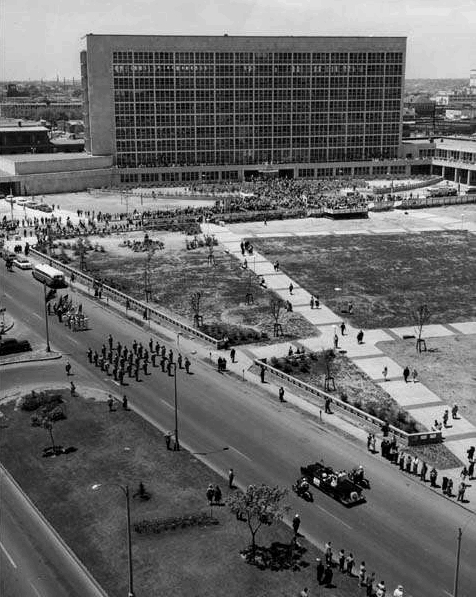
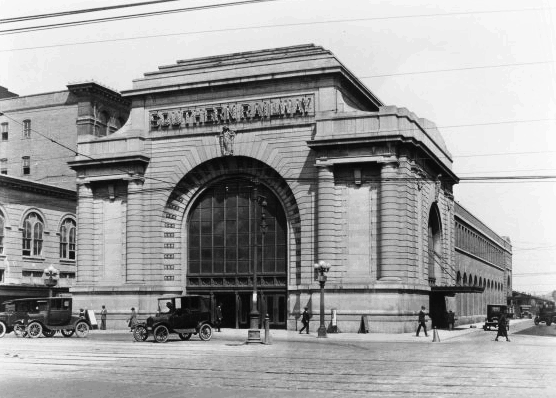 Mayor deLesseps S. Morrison's vision for New Orleans was one of a modernistic 'prgressive' hub of business activity.
He saw other cities grow by leaps and bounds after tearing down the old and bringing in the new and he envisioned the same
for our town. Morrison's administration changed the footprint of New Orleans irrevocably. One example was the demolition
of the Southern Railroad Terminal, also known as the Terminal Station, which was constructed at 1125 Canal at Basin Street
in 1908. The building was designed by Daniel Burnham, the architect for Washington D.C.'s Union Station.
Mayor deLesseps S. Morrison's vision for New Orleans was one of a modernistic 'prgressive' hub of business activity.
He saw other cities grow by leaps and bounds after tearing down the old and bringing in the new and he envisioned the same
for our town. Morrison's administration changed the footprint of New Orleans irrevocably. One example was the demolition
of the Southern Railroad Terminal, also known as the Terminal Station, which was constructed at 1125 Canal at Basin Street
in 1908. The building was designed by Daniel Burnham, the architect for Washington D.C.'s Union Station. 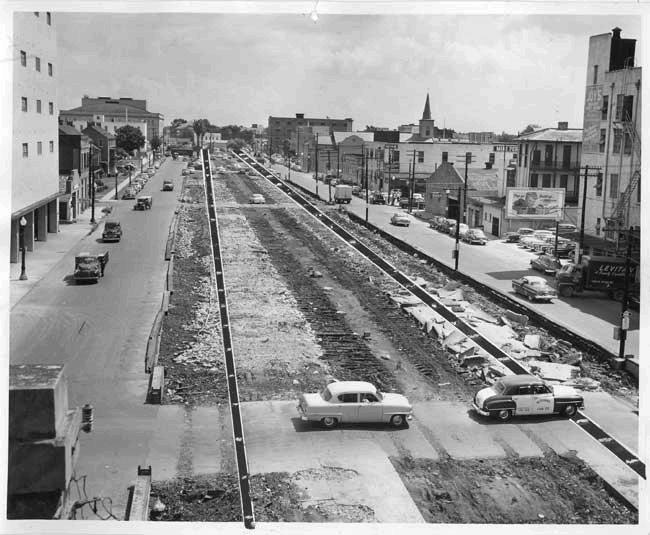
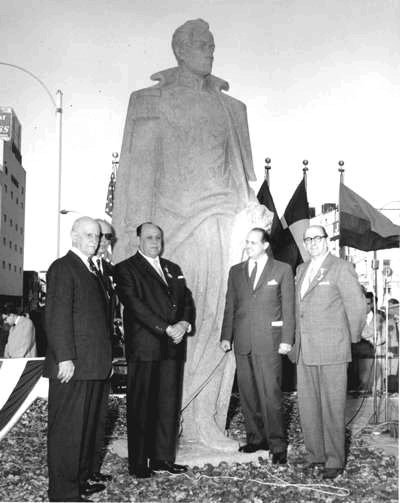
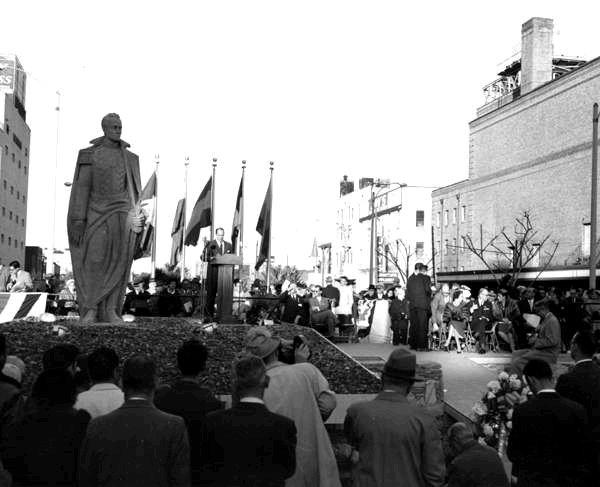 Despite the hoopla, the name for Basin Street's neutral ground as "Garden of the Americas" was officially adopted
via a city ordinance on April 14, 1957. On Monday, May 6, 1957, a "Parade of Progress"
ambled 22 blocks from the Municipal Auditorium to Basin Street at Canal where ground was broken for the plaza that would contain
Simon Bolivar's giant likeness. The Tulane band played for guests from South and Central America. The first shovel of
dirt was turned by Francisco Pacanins, Consul General of Venezuela, whose country provided $350.00 for the monument.
The parade then proceeded to the New City Hall which officially opened that day. And finally, on Monday November 25,
1957, the seven-ton, 12 foot-tall, granite statue of Simon Bolivar was unveiled. on the Basin Street neutral ground.
Despite the hoopla, the name for Basin Street's neutral ground as "Garden of the Americas" was officially adopted
via a city ordinance on April 14, 1957. On Monday, May 6, 1957, a "Parade of Progress"
ambled 22 blocks from the Municipal Auditorium to Basin Street at Canal where ground was broken for the plaza that would contain
Simon Bolivar's giant likeness. The Tulane band played for guests from South and Central America. The first shovel of
dirt was turned by Francisco Pacanins, Consul General of Venezuela, whose country provided $350.00 for the monument.
The parade then proceeded to the New City Hall which officially opened that day. And finally, on Monday November 25,
1957, the seven-ton, 12 foot-tall, granite statue of Simon Bolivar was unveiled. on the Basin Street neutral ground. 
